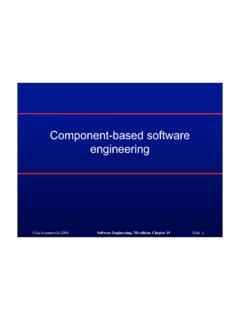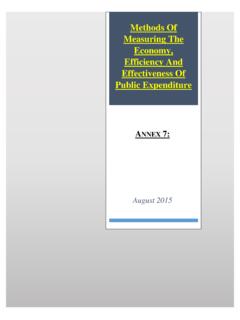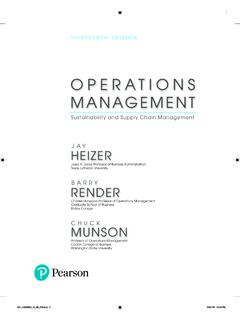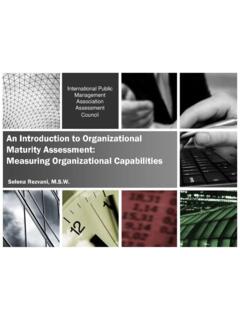Transcription of Software cost estimation - University of St Andrews
1 4/2/04 3:28 PM Page 612. 26. Software cost estimation Objectives The objective of this chapter is to introduce techniques for estimating the cost and effort required for Software production. When you have read this chapter, you will: understand the fundamentals of Software costing and reasons why the price of the Software may not be directly related to its development cost;. have been introduced to three metrics that are used for Software productivity assessment;. appreciate why a range of techniques should be used when estimating Software costs and schedule;. understand the principles of the COCOMO II model for algorithmic cost estimation . Contents Software productivity estimation techniques Algorithmic cost modelling Project duration and staffing 4/2/04 3:28 PM Page 613. Chapter 26 Software cost estimation 613.
2 In Chapter 5, I introduced the project planning process where the work in a project is split into a number of separate activities. This earlier discussion of project plan- ning concentrated on ways to represent these activities, their dependencies and the allocation of people to carry out these tasks. In this chapter, I turn to the problem of associating estimates of effort and time with the project activities. estimation involves answering the following questions: 1. How much effort is required to complete each activity? 2. How much calendar time is needed to complete each activity? 3. What is the total cost of each activity? Project cost estimation and project scheduling are normally carried out together. The costs of development are primarily the costs of the effort involved, so the effort computation is used in both the cost and the schedule estimate.
3 However, you may have to do some cost estimation before detailed schedules are drawn up. These ini- tial estimates may be used to establish a budget for the project or to set a price for the Software for a customer. There are three parameters involved in computing the total cost of a Software development project: Hardware and Software costs including maintenance Travel and training costs Effort costs (the costs of paying Software engineers). For most projects, the dominant cost is the effort cost. Computers that are power- ful enough for Software development are relatively cheap. Although extensive travel costs may be needed when a project is developed at different sites, the travel costs are usually a small fraction of the effort costs. Furthermore, using electronic communica- tions systems such as e-mail, shared web sites and videoconferencing can significantly reduce the travel required.
4 Electronic conferencing also means that travelling time is reduced and time can be used more productively in Software development. In one pro- ject where I worked, making every other meeting a videoconference rather than a face- to-face meeting reduced travel costs and time by almost 50%. Effort costs are not just the salaries of the Software engineers who are involved in the project. Organisations compute effort costs in terms of overhead costs where they take the total cost of running the organisation and divide this by the number of productive staff. Therefore, the following costs are all part of the total effort cost: 1. Costs of providing, heating and lighting office space 2. Costs of support staff such as accountants, administrators, system managers, cleaners and technicians 3. Costs of networking and communications 4/2/04 3:28 PM Page 614.
5 614 Chapter 26 Software cost estimation 4. Costs of central facilities such as a library or recreational facilities 5. Costs of Social Security and employee benefits such as pensions and health insurance. This overhead factor is usually at least twice the Software engineer's salary, depend- ing on the size of the organisation and its associated overheads. Therefore, if a com- pany pays a Software engineer $90,000 per year, its total costs are at least $180,000. per year or $15,000 per month. Once a project is underway, project managers should regularly update their cost and schedule estimates. This helps with the planning process and the effective use of resources. If actual expenditure is significantly greater than the estimates, then the project manager must take some action. This may involve applying for addi- tional resources for the project or modifying the work to be done.
6 Software costing should be carried out objectively with the aim of accurately pre- dicting the cost of developing the Software . If the project cost has been computed as part of a project bid to a customer, a decision then has to be made about the price quoted to the customer. Classically, price is simply cost plus profit. However, the relationship between the project cost and the price to the customer is not usually so simple. Software pricing must take into account broader organisational, economic, polit- ical and business considerations, such as those shown in Figure Therefore, there may not be a simple relationship between the price to the customer for the Software and the development costs. Because of the organisational considerations involved, project pricing should involve senior management ( , those who can make strategic decisions), as well as Software project managers.
7 For example, say a small oil services Software company employs 10 engineers at the beginning of a year, but only has contracts in place that require 5 members of the development staff. However, it is Bidding for a very large contract with a major oil company that requires 30 person years of effort over 2 years. The project will not start up for at least 12 months but, if granted, it will transform the finances of the small company. The oil services company gets an opportunity to bid on a project that requires 6 people and has to be completed in 10 months. The costs (includ- ing overheads of this project) are estimated at $ million. However, to improve its competitive position, the oil services company bids a price to the customer of $ million. This means that, although it loses money on this contract, it can retain specialist staff for more profitable future projects.
8 Software productivity You can measure productivity in a manufacturing system by counting the number of units that are produced and dividing this by the number of person-hours required 4/2/04 3:28 PM Page 615. Software productivity 615. Figure Factors Factor Description affecting Software pricing Market opportunity A development organisation may quote a low price because it wishes to move into a new segment of the Software market. Accepting a low profit on one project may give the organisation the opportunity to make a greater profit later. The experience gained may also help it develop new products. Cost estimate If an organisation is unsure of its cost estimate, it may uncertainty increase its price by some contingency over and above its normal profit. Contractual terms A customer may be willing to allow the developer to retain ownership of the source code and reuse it in other projects.
9 The price charged may then be less than if the Software source code is handed over to the customer. Requirements volatility If the requirements are likely to change, an organisation may lower its price to win a contract. After the contract is awarded, high prices can be charged for changes to the requirements. Financial health Developers in financial difficulty may lower their price to gain a contract. It is better to make a smaller than normal profit or break even than to go out of business. to produce them. However, for any Software problem, there are many different solu- tions, each of which has different attributes. One solution may execute more effi- ciently while another may be more readable and easier to maintain. When solutions with different attributes are produced, comparing their production rates is not really meaningful.
10 Nevertheless, as a project manager, you may be faced with the problem of esti- mating the productivity of Software engineers. You may need these productivity esti- mates to help define the project cost or schedule, to inform investment decisions or to assess whether process or technology improvements are effective. productivity estimates are usually based on measuring attributes of the Software and dividing this by the total effort required for development. There are two types of metric that have been used: 1. Size-related metrics These are related to the size of some output from an activ- ity. The most commonly used size-related metric is lines of delivered source code. Other metrics that may be used are the number of delivered object code instructions or the number of pages of system documentation.











